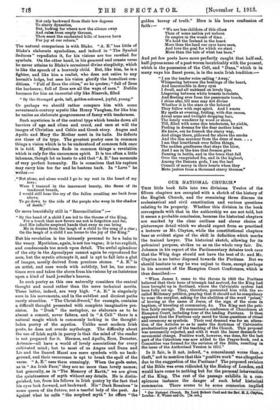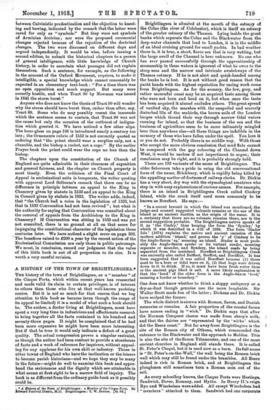OUR NATIONAL CHURCH.*
THIS little book falls into two divisions. Twelve of the fifteen chapters are occupied with a sketch of the history of the English Church, and the remaining three discuss its ecclesiastical and civil constitution and various questions relating to its property. Whether this division in the book
corresponds with that in the authorship we are not told, but it seems a probable conclusion, because the historical chapters are marked by the clear outlines and clever choice of picturesque detail which we should expect from so practised a lecturer as Mr. Clayton, while the constitutional chapters bear as evident signs of the skill in definition which marks the trained lawyer. The historical sketch, allowing for its polemical purpose, strikes us as on the whole very fair. Dr. Johnson in his report of the Parliamentary debates took care that the Whig dogs should not have the best of it: and Mr. Clayton is no better disposed towards the Puritans. But we should hesitate to say he was unjust to them, except perhaps in his account of the Hampton Court Conference, which is thus described:—
" When James I. came to the throne in 1603 the Puritans believed that their hour of triumph had arrived, for the King had been brought up in Scotland, where the Calvinistic system had been fully set up. They, therefore, presented him with the se- called Millenary petition, praying that it should not be compulsory to wear the surplice, asking for the abolition of the word 'priest,' of bowing at the name of Jesus, of the sign of the cross in baptism. of kneeling at communion, &c. The King met the peti- tion fairly enough. He summoned a conference of Churchmen at Hampton Court, including four of the leading Puritans. It then appeared that the Puritans only cared for these questions of ritual and ceremony as symbols. Their real demand was for an altera- tion of the Articles so as to make the doctrines of Calvinistic predestination part of the teaching of the Church. This proposal was necessarily rejected, and with it went the lesser demands for ceremonial change. Positive work, however, was done, for the last part of the Catechism was now added to the Prayer-book, and a Committee was formed for the revision of the Bible, resulting in the issue of the Authorized Version in 1611."
Is it fair, is it not, indeed, "a concealment worse than ,a theft," not to mention that this "positive work" was altogether due to the suggestion of the Puritans P The proposed revision of the Bible was even ridiculed by the Bishop of London, and would have come to nothing but for the personal intervention of the King. The rest of the passage exhibits in a con.
spicuous instance the danger of such lnief, historical summaries. There seems to be some connexion. implied • Our National Church, By Lord Robert Cecil And the Est. R. 7, Chilton' London: I% Warne and Co. [1s. net.3
between Calvinistic predestination and the objection to kneel- ing and bowing, indicated by the remark that the latter were eared for only as " symbols." But they were not symbols of Arminian doctrine ; nor were the proposed ceremonial changes rejected because of the rejection of the doctrinal changes. The two were discussed on different dais and argued independently. It would be wise, before issuing a second edition, to submit the historical chapters to a person of general intelligence, -with little knowledge of Church history, in order to ascertain what passages did not explain themselves. Such a sentence, for example, as the following in the account of the Oxford Movement, requires, to make it intelligible, a special knowledge which cannot reasonably be expected in an elementary text-book : "For a time there was no open opposition and much support. But Many were covertly hostile, and when Tract 90 by Newman was issued in 1841 the storm burst."
Anyone who does not know the thesis of Tract 90 will wonder . _ why the storm Should have burst then, rather than after, say, Tract 89. Some who do may possibly resent the innuendo whieh the sentence seems to contain, that Tract 90 was not the cause but only the occasion of the outburst of indigna- tion which greeted it. We have noticed a few other slips. The hour-glass on page 136 is introduced nearly a century too late ; the Ornaments rubric of 1552 is not correctly quoted as ordering that "the priest should wear a surplice only, not a chasuble, and the bishop a rochet, not a cope." By the earlier Prayer-book the priest Could Wear the cope no less than the bishop.
. The chapters upon the constitution of the Church of England are quite admirable in their clearness of exposition and general fairness, and the chapter On Church property is most timely. Even the criticism of the Final Court of Appeal in eecleaiastical suits is temperate, the writer quoting with approval Lord Selborne's remark that there can be no difference in principle between an appeal, to the King in Chancery given by statute in 1533.and an appeal to the king in Council given by statute in 1832. The writer adds, indeed, that "the Chttrch had a Voice in the legislation of 1533, but that in 1833 Convocation had not been revived " ; but what is the authority for saying that Con-Vocation was consulted about the removal of appeals from the Archbishop to the King in Chancery If CoititcietitiOn *as Sitting in 1533 and was yet not consulted, there is no ground at all on that score for ithpiigning the conititutional character of the legislation three centuries later. We have noticed a slight error on page 202.
The benefices relied to 0200 a year by the recent action of the Ecclesiastical Commission are only those in public patronage. We must, in conclusion, record our judgment that the value of this little book is out of all proportion to its size. It is worth a very careful revision.































































 Previous page
Previous page